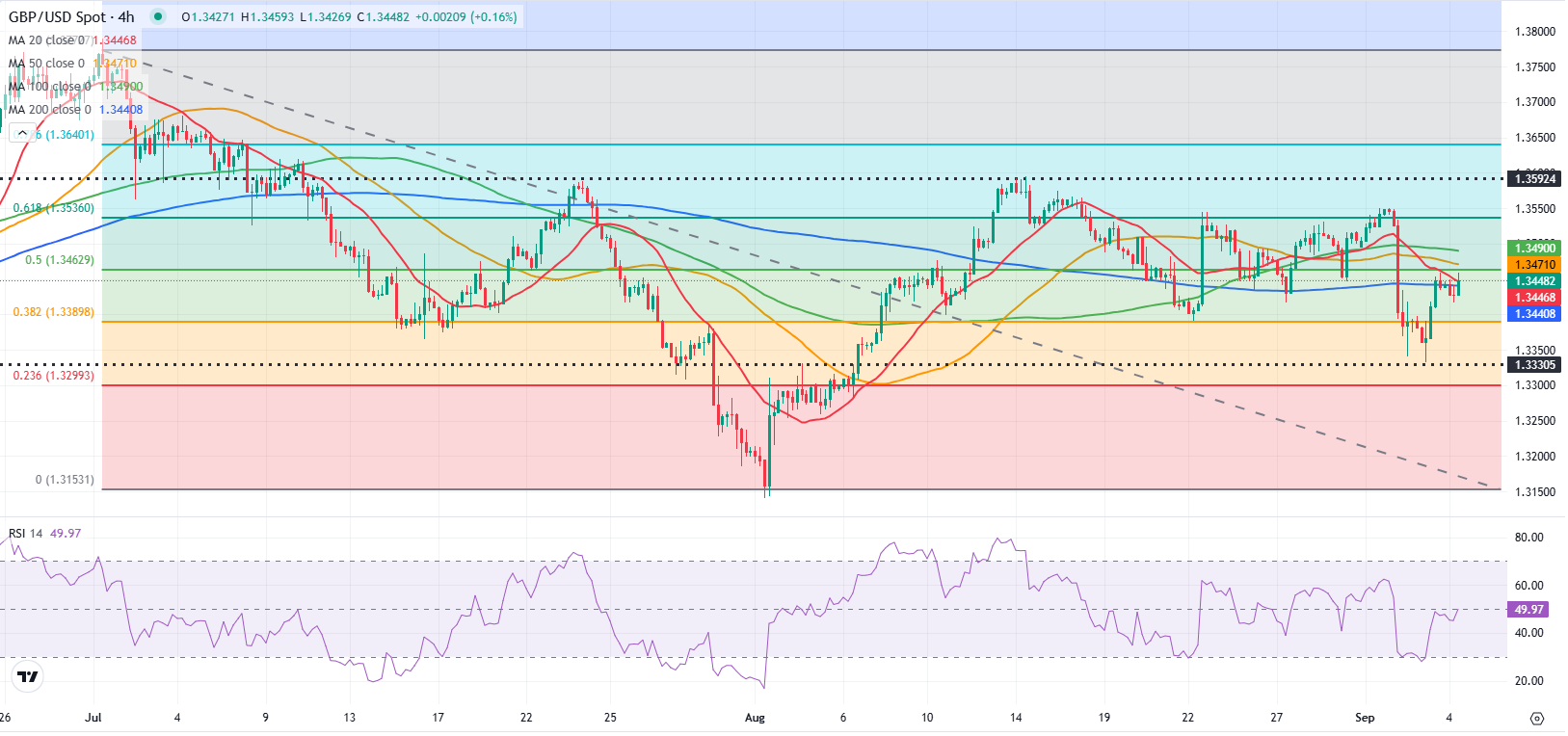
- GBP/USD stays in a consolidation phase at around 1.3450 on Thursday.
- Long-dated UK gilt yields continue to push lower following Wednesday’s decline.
- The US economic calendar will offer employment-related data releases.
Following Tuesday’s sharp decline, GBP/USD staged a rebound and closed in positive territory on Wednesday. The pair trades in a narrow band at around 1.3450 in the European session on Thursday as market focus shifts to the next batch of macroeconomic data releases from the US.
Pound Sterling Price This week
The table below shows the percentage change of British Pound (GBP) against listed major currencies this week. British Pound was the weakest against the US Dollar.
| USD | EUR | GBP | JPY | CAD | AUD | NZD | CHF | |
|---|---|---|---|---|---|---|---|---|
| USD | 0.37% | 0.37% | 0.86% | 0.61% | 0.40% | 0.51% | 0.63% | |
| EUR | -0.37% | -0.00% | 0.41% | 0.24% | 0.03% | 0.13% | 0.26% | |
| GBP | -0.37% | 0.00% | 0.32% | 0.24% | 0.03% | 0.14% | 0.31% | |
| JPY | -0.86% | -0.41% | -0.32% | -0.20% | -0.45% | -0.32% | -0.20% | |
| CAD | -0.61% | -0.24% | -0.24% | 0.20% | -0.19% | -0.12% | 0.07% | |
| AUD | -0.40% | -0.03% | -0.03% | 0.45% | 0.19% | 0.11% | 0.28% | |
| NZD | -0.51% | -0.13% | -0.14% | 0.32% | 0.12% | -0.11% | 0.17% | |
| CHF | -0.63% | -0.26% | -0.31% | 0.20% | -0.07% | -0.28% | -0.17% |
The heat map shows percentage changes of major currencies against each other. The base currency is picked from the left column, while the quote currency is picked from the top row. For example, if you pick the British Pound from the left column and move along the horizontal line to the US Dollar, the percentage change displayed in the box will represent GBP (base)/USD (quote).
Yields on the long-dated UK gilts turned south on Wednesday and supported Pound Sterling’s recovery. In the second half of the day, the US Dollar (USD) came under bearish pressure and allowed GBP/USD to stretch higher.
The US Bureau of Labor Statistics (BLS) reported that JOLTS Job Openings declined to 7.18 million in July from 7.35 million in June., missing the market expectation of 7.4 million.
Early Thursday, the yield on the 30-year UK gilt declines nearly 1% after falling 1.7% on Wednesday, helping GBP/USD keep its footing. Chancellor of the Exchequer Rachel Reeves dismissed concerns from Britain’s National Institute of Economic and Social Research (NIESR) late Wednesday. The NIESR noted that the UK faces a £50 billion budget gap and that the government may need to dip into International Monetary Fund (IMF) funding pools in the future if Parliament can’t sort out its budget issues.
The US ADP Employment Change and the Institute for Supply Management’s (ISM) Services Purchasing Managers’ Index (PMI) data for August will be featured in the US economic calendar on Thursday.
Markets expect employment in the private sector to rise by 65,000 in August. A disappointing print at or below 50,000 could be seen as a sign of a weak Nonfarm Payrolls data on Friday and weigh on the USD with the immediate reaction. On the other hand, a reading above 75,000 could be supportive for the currency and limit GBP/USD’s potential gains.
Later in the session, the Institute for Supply Management will publish the Services Purchasing Managers’ Index (PMI) report for August. If the headline PMI drops below 50 unexpectedly, the USD could come under renewed selling pressure. Conversely, a print above 50, especially if combined with an increase in the Employment Index of the survey, could cause GBP/USD to edge lower.
GBP/USD Technical Analysis

The Relative Strength Index (RSI) indicator on the 4-hour chart recovered to 50, reflecting sellers’ hesitancy.
On the upside, 1.3440-1.3460, where the 200-period SMA, Fibonacci 50% retracement of the latest downtrend and the 100-day SMA are located, remains intact as resistance. In case GBP/USD clears that hurdle, 1.3490-1.3500 (round level, 100-period SMA) could be seen as the next resistance level before 1.3535 (Fibonacci 61.8% retracement).
Looking south, support levels could be seen at 1.3390-1.3400 (Fibonacci 38.2% retracement, round level), 1.3330 (static level) and 1.3300 (Fibonacci 23.6% retracement).
Pound Sterling FAQs
The Pound Sterling (GBP) is the oldest currency in the world (886 AD) and the official currency of the United Kingdom. It is the fourth most traded unit for foreign exchange (FX) in the world, accounting for 12% of all transactions, averaging $630 billion a day, according to 2022 data. Its key trading pairs are GBP/USD, also known as ‘Cable’, which accounts for 11% of FX, GBP/JPY, or the ‘Dragon’ as it is known by traders (3%), and EUR/GBP (2%). The Pound Sterling is issued by the Bank of England (BoE).
The single most important factor influencing the value of the Pound Sterling is monetary policy decided by the Bank of England. The BoE bases its decisions on whether it has achieved its primary goal of “price stability” – a steady inflation rate of around 2%. Its primary tool for achieving this is the adjustment of interest rates. When inflation is too high, the BoE will try to rein it in by raising interest rates, making it more expensive for people and businesses to access credit. This is generally positive for GBP, as higher interest rates make the UK a more attractive place for global investors to park their money. When inflation falls too low it is a sign economic growth is slowing. In this scenario, the BoE will consider lowering interest rates to cheapen credit so businesses will borrow more to invest in growth-generating projects.
Data releases gauge the health of the economy and can impact the value of the Pound Sterling. Indicators such as GDP, Manufacturing and Services PMIs, and employment can all influence the direction of the GBP. A strong economy is good for Sterling. Not only does it attract more foreign investment but it may encourage the BoE to put up interest rates, which will directly strengthen GBP. Otherwise, if economic data is weak, the Pound Sterling is likely to fall.
Another significant data release for the Pound Sterling is the Trade Balance. This indicator measures the difference between what a country earns from its exports and what it spends on imports over a given period. If a country produces highly sought-after exports, its currency will benefit purely from the extra demand created from foreign buyers seeking to purchase these goods. Therefore, a positive net Trade Balance strengthens a currency and vice versa for a negative balance.
Information on these pages contains forward-looking statements that involve risks and uncertainties. Markets and instruments profiled on this page are for informational purposes only and should not in any way come across as a recommendation to buy or sell in these assets. You should do your own thorough research before making any investment decisions. FXStreet does not in any way guarantee that this information is free from mistakes, errors, or material misstatements. It also does not guarantee that this information is of a timely nature. Investing in Open Markets involves a great deal of risk, including the loss of all or a portion of your investment, as well as emotional distress. All risks, losses and costs associated with investing, including total loss of principal, are your responsibility. The views and opinions expressed in this article are those of the authors and do not necessarily reflect the official policy or position of FXStreet nor its advertisers. The author will not be held responsible for information that is found at the end of links posted on this page.
If not otherwise explicitly mentioned in the body of the article, at the time of writing, the author has no position in any stock mentioned in this article and no business relationship with any company mentioned. The author has not received compensation for writing this article, other than from FXStreet.
FXStreet and the author do not provide personalized recommendations. The author makes no representations as to the accuracy, completeness, or suitability of this information. FXStreet and the author will not be liable for any errors, omissions or any losses, injuries or damages arising from this information and its display or use. Errors and omissions excepted.
The author and FXStreet are not registered investment advisors and nothing in this article is intended to be investment advice.




